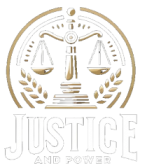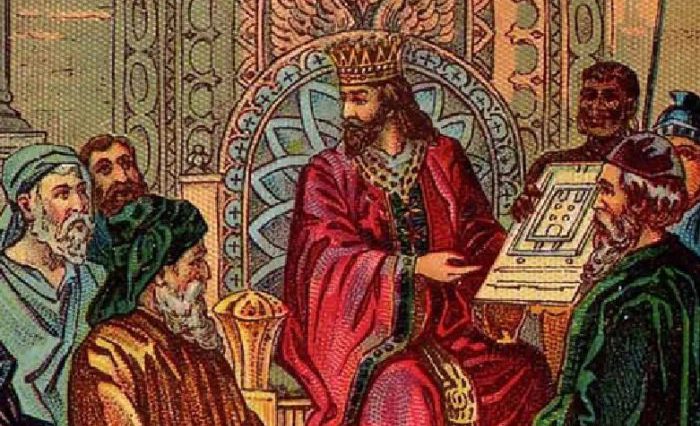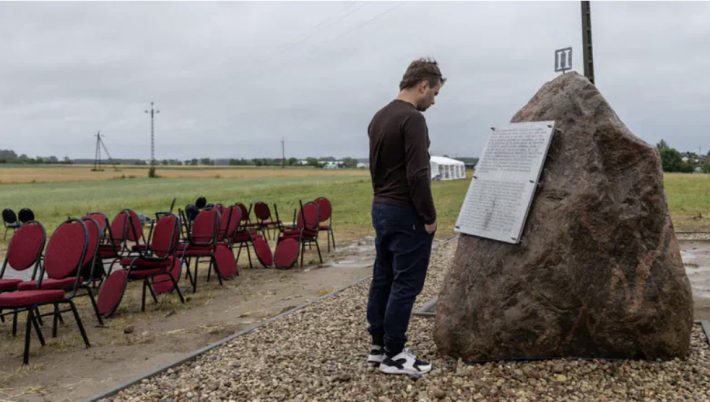A talk with Rabbi David Samson about his new English series of commentaries on the meditative path of the Kabbalist Rabbi Avraham Abulafia. “It’s as if Rav Kook bequeathed to us the map of the territory, and Rabbi Abulafia handed me the compass and walking stick.”
Having studied for twelve years at the Mercaz HaRav Yeshiva under the tutelage of Rabbi Kook’s only son, HaRav Tzvi Yehuda Kook, Rabbi David Samson is considered a leading English-speaking authority regarding Rabbi Kook’s writings, including the books “Torat Eretz Yisrael,” “Lights on Orot,” “War and Peace, and The Art of T’shuva.” Thus it may seem strange that he has just published a six-volume Kindle translation and commentary on the works of Rabbi Avraham Abulafia dealing with Rabbi Abulafia’s explorations into Prophetic Kabbalah.
The groundbreaking series presents the first comprehensible translation and in-depth analysis of Rabbi Avraham Abulafia’s “Chaye HaOlam HaBa,” making accessible the revolutionary meditative techniques and mystical insights of the renowned Kabbalist whose precisely-formulated approach transformed Jewish mysticism.
Rabbi Abraham Abulafia Chayei HaOlam HaBa (6 book series) Kindle Edition
(A hands-on-guide and tutorial on Volume 2 of Abulafia’s system will hopefully be available in a paperback edition just after Shavuot.)
Rabbi Avraham Abulafia was born in Spain in the secular year of 1240. Before turning twenty he journeyed to Eretz Yisrael but was forced to leave by Crusaders. After a decade of intensive Torah learning his encounter with the “Sefer Yetzirah” and its commentaries led him to embark on the study of Kabbalah. Throughout a turbulent life filled with controversy over his innovations in Kabbalistic meditation and teaching, he authored 26 books, plus 22 works containing descriptions of his visions.
Generations later, his methods are extensively cited in the book “Shaarei Kedusha” by Rabbi Chaim Vital, the Arizal’s foremost student. His pathway of meditation is characterized by its focus on the Hebrew letters and permutations of the Name of Hashem which incorporates chanting, head movements, and writing in a precisely outlined fashion.
In Volume 2 of “Chayei HaOlam HaBa,” Rabbi Abulafia writes: “This wisdom is the Holy of Holies, for this is the final goal of all of the paths that a mortal can fathom of the knowledge of God and the knowledge of His activities. In this way, one can recognize HaShem’s paths and appellations, because God’s Names are the closest thing to Him. They are exceedingly close, and they are the concentrated truth of the entire Torah.”
Q: Can you explain in the simplest terms possible what is meant by Kabbalistic Prophecy?
Rabbi Samson: . Kabbalistic Prophecy is the process of making yourself into a vessel that can receive Divine Insight. It’s not fortune telling or ecstatic visions. It’s about aligning your soul with God’s will through Torah, through mitzvot, through meditation and deep inner exploration. Rabbi Avraham Abulafia expounded a method that trains a person to quiet the noise of the world, purify the mind, and open the heart to spiritual awareness.
The core of prophecy is listening and learning to hear what Hashem is already whispering to every Jewish soul. Kabbalah gives the roadmap for that inner journey. You have to learn how to tune into the right channel through a familiarity with the proper codes while navigating clear of interfering static.
Q: Rabbi Kook writes a great deal about the importance of learning the secrets of Torah at the time of Israel’s Redemption. Is the work of Rabbi Abulafia what he had in mind?
Rabbi Samson: Yes and no. Rabbi Kook certainly believed that the inner dimension of Torah must be revealed as part of the redemptive process. He writes that the spiritual light buried deep in the soul of Am Yisrael must be awakened, and that can only happen through the study of the nistar – the hidden Torah.
Did he specifically point to Rabbi Abulafia? Not directly. But the themes align. Abulafia’s system is centered around prophecy, around spiritual clarity and inner purification which is exactly what Rav Kook said would return to the Jewish people in the generation of techiyat ha’uma, the National Revival. So while they come from different times and speak in different voices, I believe their visions are deeply connected.
Q: Can you describe what triggered your quest into this esoteric field of study? After learning the teachings of Rabbi Kook, is this the next stage toward attaining prophecy?
Rabbi Samson: For me, it was a gradual unfolding. I started with the teachings of Rav Kook. His writings lit a fire in me. He opened up a vision of Torah that was alive, national, prophetic. But at a certain point, I realized I needed tools. Not just the why of inner Torah, but also the how. That’s what led me to Rabbi Abulafia. His writings offer a practical path, a method to internalize what Rav Kook was describing in his lofty and poetic language.
It’s as if Rav Kook bequeathed to us the map of the territory, and Rabbi Abulafia handed me the compass and walking stick. So yes, for me, this was the natural next step. I believe that for our generation, both voices are essential—Rav Kook for the vision, and Rabbi Abulafia for the tools to begin the inner work.
Q: These matters stand at the most exalted spiritual heights of Torah. Certainly the Hebrew language is a key to this learning. Is it really possible to navigate through this world in English?
Rabbi Samson: That’s an excellent question. Hebrew is indeed the Holy Tongue – the language in which the world was created and the language of the Torah and prophecy. There’s no substitute for it. However, for those who are still climbing the ladder, English can serve as a bridge.
We live in a time of kibbutz galuyot – the ingathering of exiles – and many Jews are waking up spiritually in places far from Jerusalem. If English is the language that opens the door, then so be it. My hope is that these books will awaken a thirst for the original Hebrew, and ultimately for Eretz Yisrael itself.
Q: Our Sages have emphasized that the study of Kabbalah demands a solid foundation in basic Torah learning, including years of Talmudic study and a knowledge of Halakhah, as well as sterling character traits and spiritual holiness. Therefore, are these books for everyone who has access to an Amazon Kindle account?
Rabbi Samson: You’re absolutely right – Kabbalah is not attainable via shortcuts. It requires strong Torah roots. These books are not an invitation to bypass Halachah or deep Torah learning. On the contrary – they are a call to return. I’ve done everything possible to ensure that the content is presented responsibly, with clear guidance, background, and boundaries.
These volumes are meant to inspire serious students of Torah to expand their understanding, and to give sincere seekers a glimpse of the incredible spiritual depth that lies within our tradition. The books are open but only those who are prepared will truly understand what they hold.
Q: By making this learning available on the Internet, the secrets are no longer secrets. What do you say about that?
Rabbi Samson: This is a sensitive point. But let me offer a thought: In our generation, the concealment of secrets is no longer their protection. Ignorance doesn’t guard holiness – it often leads people to seek spiritual meaning elsewhere in foreign and polluted fields. Rav Kook wrote that in the generation of Redemption, the deeper lights of Torah must shine more openly.
The Internet, for all its dangers, is also a platform through which Torah can reach every corner of the earth. So long as the teachings are presented with yirat shamayim (reverence for Heaven) and genuine content, I believe that revealing these inner dimensions is part of the healing of the world and the return to Hashem that we need.
Q: Can you share with us some “experiences” you’ve had in your own journey into the secrets? Have you met any holy guides from “higher worlds” along the way?
Rabbi Samson: Baruch Hashem, I’ve been blessed to walk this path with incredible teachers in this world – Tzaddikim whose presence and insights opened my eyes and heart. I won’t claim visions or heavenly visitors; that’s not my way. But there have been moments in the silence of meditation, during hitbodedut in the Judean hills, or in late-night learning when something opens -and a light shines through. That is not about fantasy and flights of imagination – it’s about clarity.
You realize you’re touching a world that is deeper than words, and that world begins to shape your life. It’s not about supernatural drama – it’s about real transformation.
Q: How did you go about learning the material? Just by reading – or is a mentor needed like a spiritual WAZE?
Rabbi Samson: Definitely not just reading. These teachings require guidance. I had the merit of learning from scholars steeped in the teachings of Abulafia, Rav Kook, and other inner paths of Torah. Rav Tidhar, the Head of Yeshivat Shemen Sasson, was my guide and teacher. Beyond that, I spent decades learning the Talmud, Halakhah, and Machshava (the deeper philosophical side of Torah.) This provided the foundation.
Even now, I approach these texts with humility, often consulting with fellow Talmidei Chachamim. We all need a “spiritual WAZE” – whether a living teacher, or the words of the Tzaddikim guiding us from their writings. The inner Torah is not a solo journey. It’s a chain of transmission.
Q: What has been your experience teaching these techniques to novices?
Rabbi Samson: Surprisingly inspiring. When taught properly, with boundaries, halachic awareness, and with deep respect, people are able to connect. The spark is there in every Jew. I’ve taught high schoolers, soldiers, Rabbis, and total beginners. When the learning is authentic and rooted in Torah, it opens people up – not to escapism, but to a sense of purpose and connection. Of course, I tailor the teaching to the person. Not everyone is ready for every level. But there’s a way to introduce the light without overwhelming and shattering the vessel.
Q: Is this stuff for women as well as men?
Rabbi Samson: Absolutely. The inner dimension of Torah is not gender exclusive. Women have deep spiritual intuition and souls just as lofty as men’s. Often more so. Today, women are learning Gemara, Chassidut, Zohar – why not the writings of Rabbi Abulafia as well? Of course, just as with men, it should be done with preparation, balance, and guidance. But the soul has no gender when it comes to yearning for Hashem.
Q: What are your expectations now that the books have been published? In the past you founded several innovative educational institutions for high schoolers. Do you plan to open a school teaching these ideas?
Rabbi Samson: . The truth is, I hope the books become seeds which spark learning, reflection, and a return to our most inner roots. Not just to the mystical, but to the entirety of Torah, including an attachment to all of the Jewish People and to Eretz Yisrael.
I do believe we’re entering a time when the spirit of prophecy is beginning to awaken in our revitalized Nation – not with loud fireworks, but with an inner voice calling us home. Whether that takes the form of a school in the desert or a chavruta in Boca Raton, it’s all part of the same movement.
The goal is not to escape this world but to sanctify it and to discover its essential unity in Hashem. That’s what these teachings are ultimately about.





